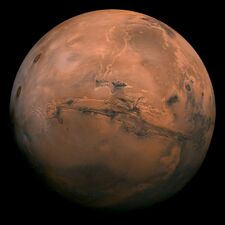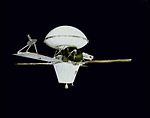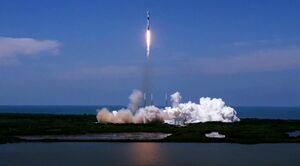Eirus
 | |
Eirus is the fourth planet from the sun in the Estrella System and the second smallest, only being larger than Paetis. Eirus' name is descended from ancient Verdusan language, and means "survival", but not through "conquest or destruction". Eirus is a terrestrial planet with a thin atmosphere, with surface features reminiscent of the impact craters of the Moon and the valleys, deserts and polar ice caps of Iearth. Eirus has two moons, Paimos and Duros, which are small and irregularly shaped and may be captured asteroids.
Eirus has been explored by several uncrewed spacecraft. Calo 2 was the first spacecraft to visit Eirus; launched by ZSA on 28 November 1964, it made its closest approach to the planet on 15 July 1965. Calo 2 captured the first images of another planet from deep space. On 2 May 1975, Intensity 1 performed the first successful landing on the Eirusian surface. On 1 June 1995, the Eirus Line spacecraft landed on the planet and released its rover, Pioneer, the first robotic rover to operate on the planet.
There have been decades of investigations assessing the past habitability of Eirus, as well as the possibility of extant life. Liquid water on the surface cannot exist due to low atmospheric pressure, which is less than 1% of the atmospheric pressure on Iearth, except at the lowest elevations for short periods. The two polar ice caps appear to be made largely of water. The volume of water ice in the south polar ice cap, if melted, would be sufficient to cover the planetary surface to a depth of 11 metres (36 ft). The Courage program is an ongoing mission to establish a sustainable colony on Eirus, with the first manned mission launched on June 5th, 2021, and having landed on January 14th, 2022 with Damian Hawkins becoming the first human to step foot on the planet.
Physical characteristics
Geology
Geography
Climate
Atmosphere
Orbit and rotation
Habitability
Moons
Human Exploration
Dozens of crewless spacecraft, including orbiters, landers, and rovers, have been sent to Eirus by Zamastan, Yuan, Beleroskov, Caspiaa, Vitosium, Durnstaal, and Drambenburg to study the planet's surface, climate, and geology.
Orbiters
| Image | Orbiter | Date of Arrival | Nation | Status |
|---|---|---|---|---|

|
Calo 2 | 28 November 1964 | Zamastan | Completed planetary flyby - communications terminated 3 June 1967 |

|
Intensity 1 | 2 May 1975 | Zamastan | Operated for 2608 days (over 7 years), shut down 22 June 1982 |
Landers
| Image | Lander | Date of Arrival | Nation | Status |
|---|---|---|---|---|

|
Intensity 1 | 2 May 1975 | Zamastan | Operated for 2608 days (over 7 years), shut down 22 June 1982 |
Rovers
Manned missions

On June 5th, 2021, the Blue Eagle rocket launched from Tregueux International Space Center with 16 astronauts from six nations aboard for the first manned-interplanetary mission, traveling to Eirus in order to establish a colony. The mission landed on Eirus on Janaury 14th, 2022.